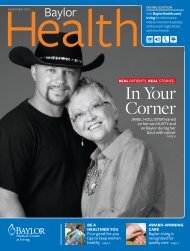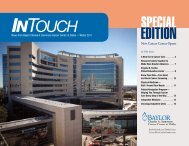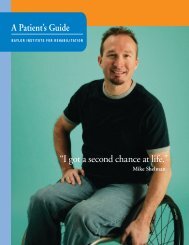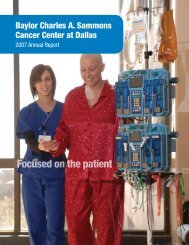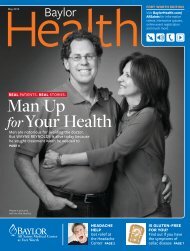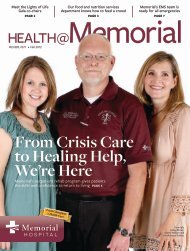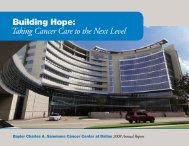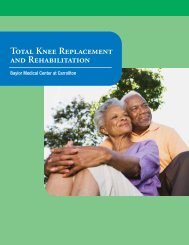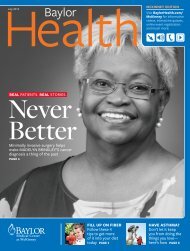Irving - Baylor Online Newsroom - Baylor Health Care System
Irving - Baylor Online Newsroom - Baylor Health Care System
Irving - Baylor Online Newsroom - Baylor Health Care System
You also want an ePaper? Increase the reach of your titles
YUMPU automatically turns print PDFs into web optimized ePapers that Google loves.
A Gentler optionRobotic techniques simplify surgeryMany people who need surgerycan now opt to have their proceduresdone with the da Vinci ® robot, whichcan minimize pain, complications andrecovery time compared with traditional,open procedures.Kevin O’Neil, MD, an obstetrician/gynecologist on the medical staff at<strong>Baylor</strong> Medical Center at <strong>Irving</strong>, isusing the robot to help treat pelvicfloor issues in women.Many women develop pelvic organprolapse when the muscles that supportthese organs become weak ordamaged during childbirth.“Surgery was traditionally donewith a big, open incision, which hada long recovery and higher infectionrates. Some doctors tried performingthe surgery vaginally, but the resultsweren’t as good,” Dr. O’Neil says.“With the da Vinci robot we have aless invasive approach for correctingthe problem. We can replicate thegold standard procedure without thebig incision.”Operating Insidethe ChestJose Escobar, MD, a cardiothoracicsurgeon on the medical staff at <strong>Baylor</strong>© 2012 Intuitive Surgical, Inc.<strong>Irving</strong>, uses the da Vinci robot toremove tumors and lymph nodes inthe chest.“Some lymph nodes are difficult tosee. With the robotic approach I haveHow It WorksThe da Vinci surgical system includesa surgical console with a video screenand hand and foot controls, and a visiontower and bedside cart outfitted with fourrobotic arms. One arm holds a 3-D, highdefinitioncamera and the other threehold miniaturized wristed instruments.This technology gives surgeons greaterprecision, control and access to hard-toreachareas. With it, complex operationsthat once demanded open surgery can beperformed through a few small incisions.2 weeksMost people can return to dailyactivities two weeks after roboticsurgery, as compared with six toeight weeks after open surgery.better visibility and I’m able to getto places without opening the chest,”he says. “When I saw the system inpractice, I was amazed at the highdefinition and 3-D visualization.”Plus, the da Vinci system reducestrauma, making it an option forpeople who have had other operationsand can’t handle a big surgery. It’salso likely to create less pain than anopen procedure.Is Robotic SurgeryRight for You?For more information on roboticsurgery or to make an appointmentat <strong>Baylor</strong> <strong>Irving</strong>, please call1.800.4BAYLOR today.thinkstock<strong>Baylor</strong><strong>Health</strong>.com/<strong>Irving</strong> 3
eaL patIents. reaL stoRIes.HaveNo FearWorried about joint replacementsurgery? We’ll put you at easeWWhen entrepreneur and race car driverEd Kennedy found out last year that he neededjoint replacement surgery on his right hip, he wasready to act fast. The momentum came from apowerful testimonial: his own left hip replacementmore than a decade before.Kennedy, who says he is “61 going on 30,” washesitant about surgery the firsttime around. “I’m always onthe go, going 100 miles an hourevery day of the week. To betied up recovering from surgerysounded like being put in jail.”But the Coppell resident knewhe had to do something. His hippain was constant, disruptinghis sleep and making it hard for him to walk or evensit through a movie with his wife.After the first operation, “it was like hitting aswitch,” Kennedy says. “The pain was gone. Thesecond time around, I couldn’t wait for that relief.”Thanks to hip replacement, Kennedy cameout of semiretirement to run several businesses,including a water park in Florida. He still races atDaytona and Talladega every year.Hear Moreof Ed’s storyTo watch a videoabout Ed’s story, visit<strong>Baylor</strong>health.com/healthcast today.After hip replacement surgery, Ed Kennedy is back to doing the thingshe enjoys, including watching movies with his wife, Pam.4 To listen to a podcast on recovering from hip replacement, visit <strong>Baylor</strong><strong>Health</strong>.com/<strong>Health</strong>cast.
fears versus factsJoint pain like Kennedy’s occurs whenthe cartilage that cushions joints isdamaged by arthritis, meaning bonerubs directly on bone, causing pain anddysfunction. If conservative treatmentssuch as medication or physical therapyaren’t enough, joint replacementsurgery is an option to relieve painand restore function.If you are considering having jointreplacement surgery but you’re afraid—as Kennedy was years ago—to take thatnext step, let us help you put your fearsto rest.FeaR #1the surgery itseLfJoint replacement is one of the mostcommon and successful orthopedicsurgeries, according to the Centersfor Disease Control and Prevention.“Ninety to 95 percent of the time,people have a good to excellent result,”says Marc S. Goldman, MD, anorthopedic surgeon on the medicalstaff at <strong>Baylor</strong> University MedicalCenter at Dallas.Fear of pain can make peoplehesitant to head to the operatingroom. “Compared to a decade ago,we do more to control postoperativepain than we used to,” says Jeffrey D.Moffett, MD, an orthopedic surgeonon the medical staff at <strong>Baylor</strong> RegionalMedical Center at Grapevine. Optionsinclude oral pain medication, injections,self-administered pain pumps andnerve blocks, which may be used incombination.The short-term pain of recovery canactually be a welcome change from thechronic pain of arthritis. “Patients tellme, ‘My pain is so different now. I canfeel that it gets better day by day, andthe pain I had before only got worse,’ ”Dr. Moffett says.FeaR #2the recovery processIf you sympathize with Kennedy’sfear that recovering from surgerywould feel like being jailed, take heart:“People think they’re going to be downfor a long period of time,” says CharlesE. Toulson, MD, an orthopedic surgeonand medical director of the Total JointReplacement Center at <strong>Baylor</strong> RegionalMedical Center at Plano. “At <strong>Baylor</strong>, weuse advanced techniques, so patientsare returning to an active lifestylemuch more quickly than before.”Typically, patients go home fromthe hospital in two to three days andparticipate in outpatient rehabilitationthree times a week for the first month,Dr. Goldman says.“Once you get past that first month,people are often already better than theywere before the surgery,” Dr. Moffettsays. “The full recovery is somewherebetween three and six months.”FeaR #3my activity LeveLwiLL changeYou’re right about this one—but mostlikely it will change for the better!It’s true that avoiding high-impactactivities reduces wear and tear on thejoint, but in general, joint replacementhelps people stay more active, not less.“Arthritis is generally a progressiveproblem that gets worse as time goesby,” Dr. Moffett says. By undergoingjoint replacement surgery, “you’relooking at a short-term hardship fora long-term gain.”After 20 years, 93 percent of kneereplacements and 95 percent of hipreplacements are still functioning well,based on current information. Withnew technology, today’s implants havethe potential to last even longer.“Joint replacement surgery changespeople’s lives,” Dr. Goldman says. “Mostpeople say, ‘I wish I’d done it sooner.’ ”Is It Time for JointReplacement?Answer these 12 questions to see ifyou might be a candidate for jointreplacement surgery.Mills Roberts, MD, an orthopedicsurgeon on the medical staff at<strong>Baylor</strong> Medical Center at <strong>Irving</strong>, says,“No one answer makes you a candidatefor joint replacement surgery.But if you answer ‘yes’ to any ofthese questions, it’s worth talking toyour doctor about options to controlyour joint pain.”1. Have X-rays uncovered significantdamage to your joint?2. Does your pain make it difficultor impossible to shop, do houseworkor do the daily activities you enjoy?3. Is your joint pain affecting yourjob?4. Are you unable to lose weightbecause of knee pain?5. Does your joint pain limit yoursocial interaction?6. Is joint pain affecting your sleepor waking you up at night?7. Is it difficult for you to get upafter sitting?8. Has your pain lasted more thana year?9. Do you find it hard to manageyour joint pain with medication, ordo you need increasing doses ofmedication to control the pain?10. Have you tried conservativetreatment measures such as exercise,physical therapy, injections andweight loss without success?11. Are your bones, cartilage ormuscles worsening, making recoveryfrom surgery potentially moredifficult in the future?12. Do you feel depressedbecause of your knee pain?Say Goodbye toJoint PainTo learn more about jointreplacement surgery at <strong>Baylor</strong> <strong>Irving</strong>or to find an orthopedic surgeonon the medical staff at <strong>Baylor</strong><strong>Irving</strong>, call 1.800.4BAYLOR or visit<strong>Baylor</strong><strong>Health</strong>.com/<strong>Irving</strong>.<strong>Baylor</strong><strong>Health</strong>.com/<strong>Irving</strong> 5
studying stress<strong>Baylor</strong> researchers look at the effects of working with trauma patientsanyone Who has Watched amedical drama on TV can imagine howstressful it is to work with criticallyinjured patients.<strong>Baylor</strong> researchers are examining justhow much this stress can affect healthcare providers. What’s more, they wantto learn what might be done to easeor prevent what’s known as secondarytraumatic stress.Secondary traumatic stress is similarto post-traumatic stress disorder,says Ann Marie Warren, PhD, ABPP, alicensed psychologist and an associateinvestigator of trauma research inthe Level I Trauma Center at <strong>Baylor</strong>University Medical Center at Dallas.“The empathy that draws peopleto the health care profession actuallymakes us susceptible to secondarytraumatic stress,” she explains.Clinicians experiencing secondarytraumatic stress might find themselvesthinking too much about the traumaticstories they hear or having nightmaresthat the traumas are happening tothem. Other symptoms include troublesleeping and irritability.As a Level I Trauma Center, <strong>Baylor</strong>Dallas treats some of the area’s mostcritically injured patients. The study islooking at every discipline that caresfor trauma patients, including doctors,nurses, surgeons, emergency medicalpersonnel and rehabilitation therapists.Researchers want to better understandnot only the incidence of secondarytraumatic stress but also the theory thatthe more resilient medical personnel are,the less likely they might be to developsecondary traumatic stress.By gathering data on the clinicians’backgrounds, experiences and reactionsto patients, the researchers hope tobetter understand secondary traumaticstress. This knowledge may be able tohelp them develop management andprevention strategies.Although the study is focused ontrauma clinicians, the researchershope to expand their work to includeother medical specialties, as well asfamily members who are caring fortrauma patients.“Family members aren’t usuallyprofessional caregivers, so you canimagine that the experience of livingthrough these events is significant,”Dr. Warren says. “As for our clinicians,we want to help take care of them andimprove their quality of life—whichcan ultimately translate into betterpatient care.”Are You a clinician?The study of secondary Traumaticstress in clinicians is limited to<strong>Baylor</strong> Dallas personnel, but itmay be open to other health careproviders in the future. Emailannmariw@<strong>Baylor</strong>health.edu orcall 214.820.4460 to learn more.6 <strong>Baylor</strong><strong>Health</strong>.com
105,000The number ofpeople in Texas whowere diagnosed withcancer in 2011.covering all the basesCancer program, breast cancer specialty at<strong>Baylor</strong> <strong>Irving</strong> are both recognized with accreditation<strong>Baylor</strong> Medical Center at <strong>Irving</strong>recently received national accreditationfrom both the Commissionon Cancer and the NationalAccreditation Program for BreastCenters. Accreditation means that<strong>Baylor</strong> <strong>Irving</strong> measures its cancercare and breast care standards againstother programs across the country.“Being vetted by a national cancerorganization means our programmeets a set of standards that anational organization says we shouldmeet. If I was a consumer of healthcare, my preference would be to go toa program that could document that itmet those standards,” says Ed Clifford,MD, a surgeon and the medical directorfor oncology services at <strong>Baylor</strong> MedicalCenter at <strong>Irving</strong>. “Lots of facilities saythey provide high-quality care. Thisaccreditation offers proof in an objectivecomparison to every other facilityin the country.“The accreditation attests that wehave achieved a level of quality andrecognition,” says Dr. Clifford. “It’s anQuality Acrossthe BoardAn accredited cancer programneeds to meet or exceed standardsin a range of areas including:• Leadership• Clinical management• Research• Community outreach• Professional education• Quality improvementobjective testament to our process fordiagnosing and treating cancers. Mostcenters don’t have this validation ofthe whole cancer program from someoneon the outside.”The multidisciplinary approach tocancer care at <strong>Baylor</strong> <strong>Irving</strong> includes:• Medical oncology• Surgical oncology• Radiation oncology• Community involvementAnand Shivnani, MD, a radiationoncologist on the medical staff at<strong>Baylor</strong> <strong>Irving</strong> points out that keepingthe community healthy is a key componentin cancer care. To that end, <strong>Baylor</strong><strong>Irving</strong> sponsors screenings at companiesand community organizations tohelp uncover cancer at its earliest, mostcurable stages.“As a physician, I want to helpmaintain the health of the communityas a whole,” Dr. Clifford says. “And Iwant people to know of the servicesavailable at <strong>Baylor</strong> <strong>Irving</strong> so they don’thave to drive across town to get care.”Get the Cancer <strong>Care</strong> You NeedFor an appointment with a physician specializing in cancer care, pleasecall 1.800.4BAYLOR or visit FindDrRight.com today. To learn moreabout the services that are offered at the <strong>Baylor</strong> <strong>Irving</strong> Cancer Center,visit <strong>Baylor</strong><strong>Health</strong>.com/<strong>Irving</strong>Cancer.<strong>Baylor</strong><strong>Health</strong>.com/<strong>Irving</strong> 7
<strong>Baylor</strong> <strong>Health</strong> <strong>Care</strong> <strong>System</strong>2001 Bryan Street, Suite 750Marketing DepartmentDallas, TX 75201NON-PROFIT ORG.US POSTAGEPAIDBAYLOR HEALTH<strong>Baylor</strong> <strong>Irving</strong> hasthe only accreditedcomprehensive cancerprogram in <strong>Irving</strong>and Las Colinas.Commissionon CancerAccredited Comprehensive CancerProgram by the American Collegeof Surgeons Commission on CancerFor a physician referral or for more information about cancercare services, call 1.800.4BAYLOR or visit us online at<strong>Baylor</strong><strong>Health</strong>.com/<strong>Irving</strong>Cancer.1901 N. MacArthur Blvd.<strong>Irving</strong>, TX 75061Physicians are members of the medical staff at one of <strong>Baylor</strong> <strong>Health</strong> <strong>Care</strong> <strong>System</strong>’s subsidiary, community, or affiliated medical centers and are neither employees nor agentsof those medical centers, <strong>Baylor</strong> Medical Center at <strong>Irving</strong>, or <strong>Baylor</strong> <strong>Health</strong> <strong>Care</strong> <strong>System</strong>. ©2012 <strong>Baylor</strong> <strong>Health</strong> <strong>Care</strong> <strong>System</strong>. BMCIrv_384_2012 BHM CE 04.12



